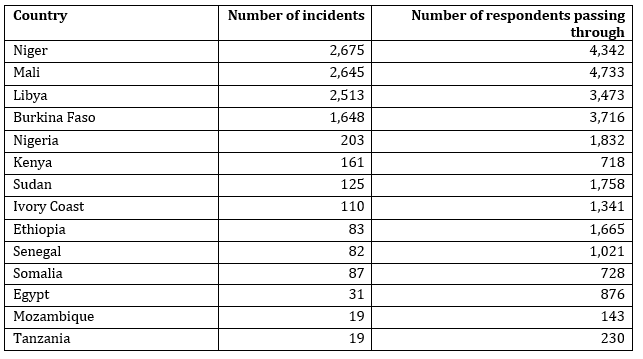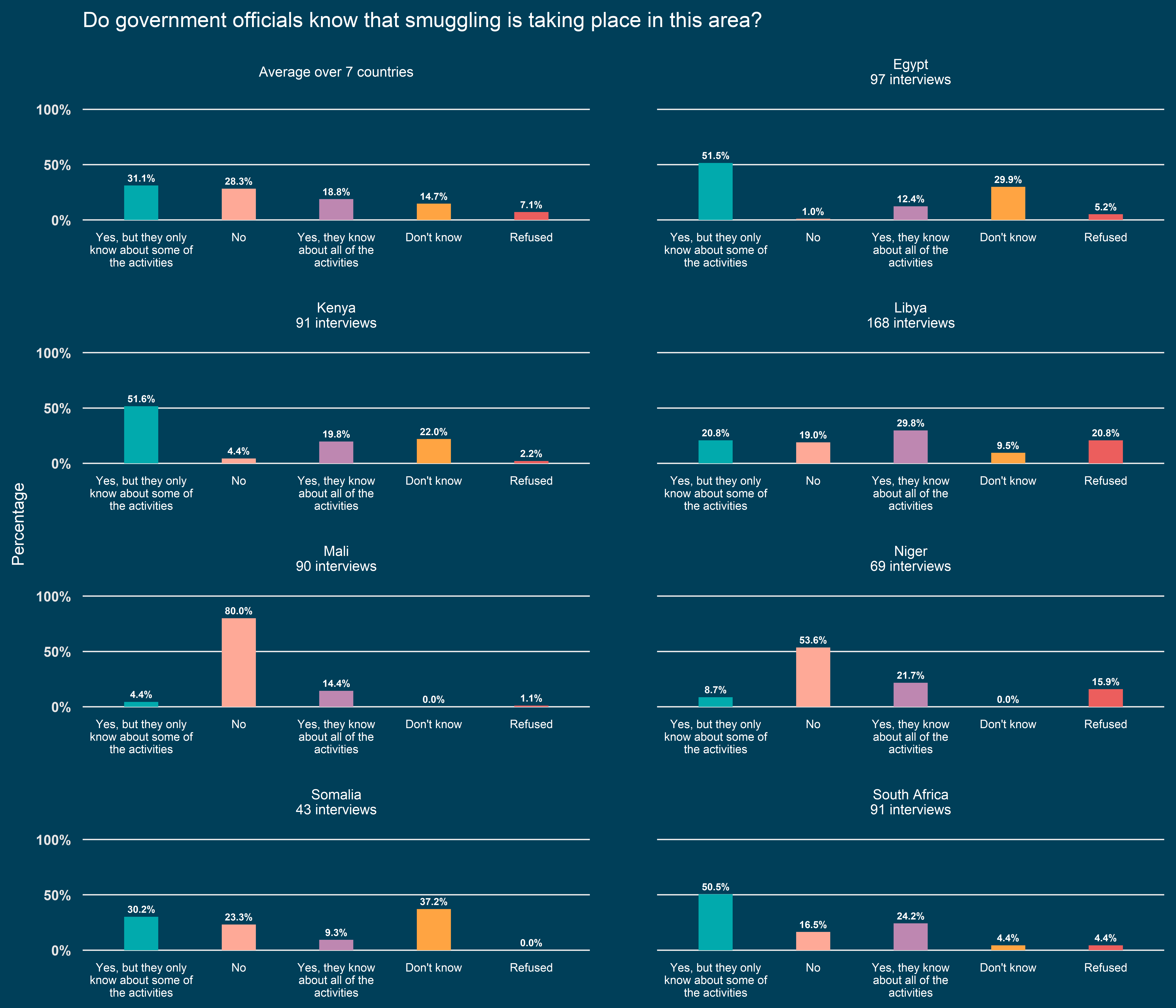Corruption, the abuse of entrusted power for private gain, involves illicit activities such as bribery, embezzlement, fraud, extortion, or nepotism. These activities take place in secrecy and therefore their influence is difficult to measure. However, MMC’s 4Mi interviews with people on the move in mixed migration flows provide valuable insights. They show how corruption impacts both people’s motivation to leave their homeland and their ability to reach their destination.
Corruption as a driver
While the drivers of migration are always diverse and complex, 4Mi data indicates that corruption of authorities in origin countries is an important reason for people to leave their home country. In 4Mi interviews conducted between May 2017 and March 2019, along 5 different migration routes out of West and East Africa[1], 19% (1,941) of 10,472 respondents cited a lack of social services or poor governance as a main driver. Of those, 74% along all 5 routes, and close to 90% of the respondents interviewed along the route from the Horn of Africa towards North Africa and Europe, further specified that corruption in government, politics and police was the major factor.
These findings are reaffirmed by this literature review on the relationship between corruption and migration, which concludes that increased corruption correlates directly with an increase in the levels of migration from a country. Other researchers have identified that corruption increases emigration among workers at all education levels, and that countries where corruption is perceived to be widespread are largely countries of emigration. Furthermore, corruption has also been linked to violent conflict (which is a major cause of migration) because it creates tensions between groups when resources are diverted to favour one group, and because it enables destabilizing activities such as arms deals and organized crime.
The 4Mi finding that corruption is an important migration driver for African refugees and migrants is not surprising considering that Sub-Saharan Africa is the lowest scoring region in Transparency International’s Corruption Perceptions Index, an annual ranking of countries by their perceived levels of public sector corruption.
Corruption as a facilitator
According to the 4Mi database, people in mixed migration flows often depend on the existence of corrupt border officials or government clerks to facilitate their journeys. These 4Mi findings are in line with a report by RMMS (MMC’s predecessor in East Africa), which found that without corruption of state officials it would be much harder for people on irregular migration routes to get across borders, and with a United Nations University study, which identified that corruption facilitates or speeds up both regular and irregular migration processes.
On average about a third of the 10,472 African migrants and refugees interviewed by 4Mi said they had to bribe government officials during their journey. The rates are particularly high among West Africans on routes through the Sahel to North Africa or Europe.
Graph 1: Did you have to give government officials gifts, services or bribes during your journey?
Until they reach Libya, these West Africans remain within the free movement region of ECOWAS, yet bribing officials is common practice during their journeys. Among West Africans interviewed by 4Mi in Niger – and who had therefore not yet left the ECOWAS region – the percentages of those saying they had to pay a bribe are generally between 50 and 100%, depending on the country of origin. 4Mi respondents report a high number of bribery incidents in Niger Mali, Libya and Burkina Faso. For example, the 4,342 people interviewed who passed through Niger reported a total of 2,675 bribing incidents.
Table 1: Prevalence of bribery in selected countries
In other countries, the prevalence of bribery is quite low. In some cases, like Nigeria, Ivory Coast and Senegal, this is to be expected. For respondents interviewed by 4Mi further along the migration route who indicated they have travelled through one of these countries at some point in their journey, these are primarily their countries of origin, with less need to bribe officials to be able to move around in their own countries.
With regard to other countries on this list, such as Sudan, Kenya and Mozambique, 4Mi primarily interviewed foreigners migrating through these countries and the relatively low number of incidents is more surprising – and worth further exploration through 4Mi data analysis – especially in countries which rank 172 (out of 180), 144 and 158, respectively, on Transparency International’s Corruption Perceptions Index.
Corruption is big business in the migration industry
The 10,472 respondents reported a total of 9,732 incidents of bribery. In those incidents they paid a total amount of USD 361,392 to government officials. The table below presents the average amount per bribe according to respondents across 5 different migration routes through Africa.
Table 2: Average amount per bribe 
These amounts are very similar to findings in other studies. In a chapter called ‘From One Stage to the Next: Transit and Transport in (trans)Saharan Migrations’ (published in the 2012 book African Migrations Research), Julien Brachet reported migrants paying between 6,500 CFA (11 USD) and 31,000 CFA (52 USD) in bribes to state officials at various points between Agadez (Niger) and the Algerian and Libyan borders. Based on the estimated numbers of migrants travelling along these routes between 2003 and 2008, Brachet estimated the annual total amount illegally taken from migrants at between 861 million CFA and 3.4 billion CFA (between 1.6 and 6.4 million USD using 2012 exchange rates).
In a more recent, upcoming study on mixed migration and border security management in the Liptako-Gourma area (border area between Mali, Niger and Burkina Faso), findings from 4Mi interviews with refugees and migrants reveal the systematic ‘informal taxes’ required to pay at borders and internal checkpoints across the West African region. In line with the amounts presented in table 1, this study also found that the requested amounts per incident in West Africa are usually small, sometimes between 1-4 USD, although undocumented migrants pay larger sums between 8 and 16 USD. Reportedly, in some places the requested amounts are increasing. A 2017 study by Clingendael found that with the additional competences and resources of police and security forces, the ability of security actors to levy informal taxes or bribes along the migration value chain has increased, with skyrocketing extortion rates. Clingendael found that since the beginning of enforcement of the anti-smuggling law in Niger, the number of checkpoints on the road between Niamey and Agadez has increased to 10. At every checkpoint, migrants and refugees are requested to pay at least 17 USD to continue their journey, amounting to a total of 225 USD per person.
Some of these amounts may seem relatively low. However, given the total number of people passing through these routes, the proceeds are high and these bribes provide a substantial source of income for the government officials involved. For example, in 2018 close to 150,000 people from the Horn of Africa arrived in Yemen. With an average amount per bribe of 60 USD (based on interviews conducted in Somalia/Somaliland and Djibouti alone) the collective income in bribes earned from refugees and migrants by certain state officials may well amount to around 9 million USD per year. Though corruption is by nature hard to quantify and such calculations come with many limitations, assumptions and caveats, it is safe to assume, based on the primary data from 4Mi, that bribes paid by refugees and migrants on the move constitute a multimillion-dollar business along the various migration routes through Africa.
The smugglers’ perspective on corruption
Between May 2017 and March 2019, 4Mi interviewed 649 smugglers in Egypt, Kenya, Libya, Mali, Niger, Somalia and South Africa. On average across countries, half of them said that government officials are aware that smuggling is taking place – with particularly high indications in Egypt, Kenya and South Africa. Nearly 40% answered that they or somebody in their network has direct contact with government officials to facilitate migrant smuggling.
Graph 2: Awareness of government officials of migrant smuggling[2] 
Asked about active participation by some government officials, 21.2% of the smugglers (across all routes) said government officials are actively involved, while 39% said they are not, but they turn a blind eye to smuggling. In Mali (51.1%) and Egypt (75.3%) smugglers say government officials primarily turn a blind eye, while smugglers in Libya (39.3%) and South Africa (56%) report relatively higher percentages of active involvement of government officials compared to other routes.
The arrest and detention of smugglers provides an additional source of income for corrupt law enforcement personnel, as smugglers caught by authorities manage to usually pay their way out. More than 57% of the smugglers interviewed said they bribed public officials to avoid detention after arrest and nearly half said they paid bribes to be released from detention. The UN’s Office on Drugs and Crime (UNDOC) argues that combating corruption is an essential element of any effective strategy to address migrant smuggling because widespread corruption weakens existing state systems and measures to protect borders, control immigration, and enforce the law.
In conclusion, corruption is strongly intertwined with the mixed migration phenomenon: it both shapes people’s aspirations to leave and functions as an important facilitator of the migration process. Corruption is pervasive within mixed migration flows; it involves a large number of people and generates considerable revenue. The data presented in this article shows that corruption cannot be overlooked. Any dialogue or cooperation with states on the so-called ‘root causes’ of migration and migration governance must address corruption if it is to be effective and reflective of this persistent reality on the ground.
[1] Horn of Africa to North Africa/Europe; Horn of Africa to South Africa; Horn of Africa to Yemen/Saudi Arabia; West Africa to North Africa/Europe; West Africa to Sahel. Refer to page 12 of the Mixed Migration Review 2018 for an explanation on how 4Mi assigns respondents to these various routes and the methodological limitations.
[2] Cross-regional data on smugglers is presented by country of operation of the smugglers, as opposed to data from refugees and migrants on the move, which is presented by migration route.